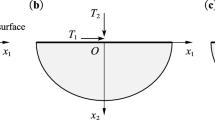Abstract
Crack tip fields are calculated under plane strain small scale yielding conditions. The material is characterized by a finite strain elastic–viscoplastic constitutive relation with various hardening–softening–hardening hardness functions. Both plastically compressible and plastically incompressible solids are considered. Displacements corresponding to the isotropic linear elastic mode I crack field are prescribed on a remote boundary. The initial crack is taken to be a semi-circular notch and symmetry about the crack plane is imposed. Plastic compressibility is found to give an increased crack opening displacement for a given value of the applied loading. The plastic zone size and shape are found to depend on the plastic compressibility, but not much on whether material softening occurs near the crack tip. On the other hand, the near crack tip stress and deformation fields depend sensitively on whether or not material softening occurs. The combination of plastic compressibility and softening (or softening–hardening) has a particularly strong effect on the near crack tip stress and deformation fields.













Similar content being viewed by others
References
Hutchens, S.B., Needleman, A., Greer, J.R.: A microstructurally motivated description of the deformation of vertically alligned carbon nanotube structures. Appl. Phys. Lett. 100, 121910 (2012)
Mohan, N., Cheng, J., Greer, J.R., et al.: Uniaxial tension of a class of compressible solids with plastic non-normality. J. Appl. Mech. 80, 040912 (2013)
Hwang, K.C., Luo, X.F.: Near-tip fields for cracks growing steadily in elastic-perfectly-plastic compressible material. In: IUTAM Symposium on Recent Advances in Nonlinear Fracture Mechanics, Pasadena (1988)
Li, F.Z., Pan, J.: Plane-strain crack-tip fields for pressure-sensitive dilatant materials. J. Appl. Mech. 57, 40–49 (1990)
Yuan, H., Lin, G.: Elastoplastic crack analysis for pressure-sensitive dilatant materials, part I: higher-order solutions and two-parameter characterization. Int. J. Fract. 61, 295–330 (1993)
Yuan, H.: Elastoplastic crack analysis for pressure-sensitive dilatant materials, part II: interface cracks. Int. J. Fract. 69, 167–187 (1994)
Chang, W.J., Kim, M., Pan, J.: Quasi-statically growing crack-tip fields in elastic perfectly plastic pressure-sensitive materials under plane strain conditions. Int. J. Fract. 84, 203–228 (1997)
Lai, J., Van der Giessen, E.: A numerical study of crack-tip plasticity in glassy polymers. Mech. Mater. 25, 183–197 (1997)
McMeeking, R.M.: Finite deformation analysis of crack tip opening in elastic-plastic materials and implications for fracture. J. Mech. Phys. Solids 25, 357–381 (1977)
Gearing, B.P., Anand, L.: Notch-sensitive fracture of polycarbonate. Int. J. Solids Struct. 41, 827–845 (2004)
Long, R., Hui, C.-Y.: Crack tip fields in soft elastic solids subjected to large quasi-static deformation–a review. Extrem. Mech. Lett. 4, 131–155 (2015)
Hutchens, S.B., Needleman, A., Greer, J.R.: Analysis of uniaxial compression of vertically aligned carbon nanotubes. J. Mech. Phys. Solids 59, 2227–2237 (2011)
Rice, J.R.: A path independent integral and the approximate analysis of strain concentration by notches and cracks. J. Appl. Mech. 90, 379–386 (1968)
Needleman, A., Tvergaard, V., van der Giessen, E.: Indentation of elastically soft and plastically compressible solids. Acta Mech. Sin. 31, 473–480 (2015)
Needleman, A., Hutchens, S.B., Mohan, N., et al.: Deformation of plastically compressible hardening-softening-hardening solids. Acta Mech. Sin. 28, 1115–1124 (2012)
Deshpande, V.A., Fleck, N.A.: Isotropic constitutive models for metallic foams. J. Mech. Phys. Solids 48, 1253–1283 (2000)
Peirce, D., Shih, C.F., Needleman, A.: A tangent modulus method for rate dependent solids. Compos. Struct. 18, 875–887 (1984)
Shih, C.F.: Relationships between the J-integral and the crack opening displacement for stationary and extending cracks. J. Mech. Phys. Solids 29, 305–326 (1981)
Hutchinson, J.W.: Singular behavior at the end of a tensile crack in a hardening material. J. Mech. Phys. Solids 16, 337–347 (1968)
Rice, J.R., Rosengren, G.F.: Plane strain deformation near a crack tip in a power law hardening material. J. Mech. Phys. Solids 16, 1–12 (1968)
Author information
Authors and Affiliations
Corresponding author
Rights and permissions
About this article
Cite this article
Khan, D., Singh, S. & Needleman, A. Finite deformation analysis of crack tip fields in plastically compressible hardening–softening–hardening solids. Acta Mech. Sin. 33, 148–158 (2017). https://doi.org/10.1007/s10409-016-0614-y
Received:
Revised:
Accepted:
Published:
Issue Date:
DOI: https://doi.org/10.1007/s10409-016-0614-y




